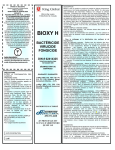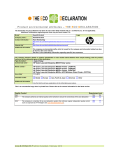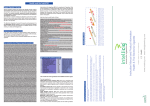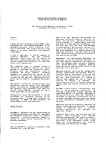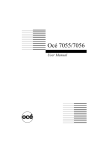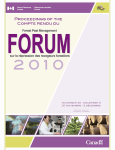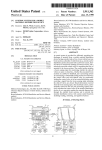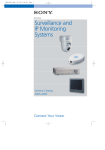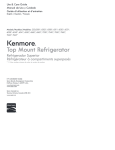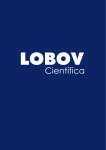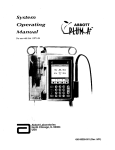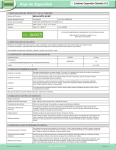Download Oil encapsulation
Transcript
US 20060263402A1 (19) United States (12) Patent Application Publication (10) Pub. No.: US 2006/0263402 A1 (43) Pub. Date: Deckner et al. (54) OIL ENCAPSULATION (75) Inventors: George Endel Deckner, Cincinnati, OH (US); Michael Jude LeBlanc, Cincinnati, OH (US); Jiten Odhavji Dihora, Hamilton, OH (US) NOV. 23, 2006 Publication Classi?cation (51) Int. Cl. A61K 8/02 (52) Us. or. ............................................................ ..424/401 (2006.01) Correspondence Address: THE PROCTER & GAMBLE COMPANY INTELLECTUAL PROPERTY DIVISION (57) ABSTRACT WINTON HILL BUSINESS CENTER - BOX 161 6110 CENTER HILL AVENUE According to the invention, a solid encapsulate is provided CINCINNATI, OH 45224 (US) comprising: (73) Assignee: The Procter & Gamble Company (a) an oil phase; (21) Appl. No.: 11/437,162 (22) Filed: May 19, 2006 (b) a Water-soluble emulsi?cation polymer, Wherein a 0.1 %Wt aqueous solution of the Water-soluble emulsi?cation polymer has a surface tension of 15-60 mN/m (15-60 Related US. Application Data (60) Provisional application No. 60/682,600, ?led on May 19, 2005. dynes/cm) When measured at 250 C.; (c) a Water-soluble ?lm-forming polymer; Wherein the Water-soluble emulsi?cation polymer is differ ent from the Water-soluble ?lm-forming polymer. Patent Application Publication Nov. 23, 2006 Fig.1 US 2006/0263402 A1 Nov. 23, 2006 US 2006/0263402 A1 OIL ENCAPSULATION CROSS REFERENCE TO RELATED APPLICATION [0001] This Application claims the bene?t of US. Provi sional Application No. 60/682600, ?led May 19, 2005. [0010] According to a second aspect of the invention, a method is provided for the manufacture of the solid encap sulate according to the ?rst aspect of the invention, com prising the steps of: [0011] (A) forming a high internal phase (HIP) oil-in Water emulsion comprising, by Weight of the HIP phase emulsion: FIELD OF THE INVENTION [0002] The present application relates to encapsulates comprising an oil phase a Water-soluble emulsi?cation poly mer and a Water-soluble ?lm-forming polymer, to a method for making the encapsulates and to products comprising the encapsulates. [0012] (i) from 0.25% to 7% Water-soluble emulsi?ca tion polymer; [0013] (ii) more than 60%, preferably from 70% to 90% oil phase; and [0014] (iii) Water; BACKGROUND OF THE INVENTION [0003] It is knoWn to encapsulate hydrophobic active [0015] (B) forming an aqueous solution of the Water soluble ?lm-forming polymer comprising from 5% to 40% ingredients, such as perfumes, in other materials, such as Water-soluble ?lm-forming polymer by Weight of the aque gums, cyclic oligosaccharides and starches, in order, for example to delay release of the encapsulated materialsi ous solution; reference is made, for example, to EP 0 303 461. Thus [0016] encapsulated active ingredients may be incorporated into aqueous solution of step B to form an aqueous pre-mixture; any number of products to achieve the bene?t of delayed (C) mixing the HIP emulsion of step A With the release4examples of such products include cosmetic prod [0017] (D) drying the aqueous pre-mixture of step C to ucts, such as fragrances, poWders and deodorants; fabric treatment products, such as Washing poWders and fabric softening sheets and Wipe products, Which may have cos Water by Weight of the encapsulate. metic or hygiene applications (for example in baby-care products). [0004] form solid encapsulate comprising less than or equal to 10% [0018] Solid encapsulate obtainable according to the method of the second aspect of the invention also forms part of the present invention. For a number of reasons, starches are often used to encapsulate active ingredients: in the ?rst place, starches are safe, mild and environmentally friendly naturally derived [0019] According to a third aspect of the invention, a laundry product, especially a granulated detergent or a fabric ingredients, being found in corn, Wheat, rice and potatoes, softening sheet, is provided comprising from 0.01% to 30%, for example. Their use thus meets an increasing consumer preferably from 0.10% to 12%, more preferably 0.10% to preference for products comprising safe, naturally derived 5% by Weight of the encapsulate of the ?rst aspect of the materials. Secondly, starches may bestoW advantageous invention. sensory properties, such as improved lather, enriched tex ture, superior feel on application and improved after appli cation feel, to consumer products, especially in the cosmetic area. [0005] On the other hand, raW, unmodi?ed naturally derived starch may have poor aesthetics and functionality. It is therefore normal to modify it: such modi?cation may be physicaliit is common to “pre-gelatinise” starch to render it dispersible in cold Water and cold-processable. It is also [0020] According to a fourth aspect of the invention, a personal care product, especially a bar soap or an antiper spirant composition, is provided comprising from 0.01% to 30%, preferably from 0.10% to 12%, more preferably 0.10% to 5% by Weight of the encapsulate of the ?rst aspect of the invention. their viscosity stability and their tolerance of high stress and [0021] While the speci?cation concludes With claims Which particularly point out and distinctly claim the inven tion, it is believed the present invention Will be better understood from the folloWing description of preferred embodiments taken in conjunction With the accompanying shear. The hydrophobic modi?cation can be time consum draWing. standard to chemically modify starches used for encapsula tion purposes to render them more hydrophobic, increase ing, complicated and costly. It Would therefore be advanta geous to ?nd a straightforWard Way of encapsulating active [0022] FIG. 1 is scanning electron microscope (SEM) ingredients in starch that has not been hydrophobically image of a particulate encapsulate according to the inven tion, that has been broken open. modi?ed. SUMMARY OF THE INVENTION [0006] According to a ?rst aspect of the invention, a solid encapsulate is provided comprising: DETAILED DESCRIPTION OF THE INVENTION [0023] All Weights, measurements and concentrations [0007] (a) an oil phase; [0008] (b) a Water-soluble emulsi?cation polymer, herein are measured at 250 C. on the composition in its Wherein a 0.1 %Wt aqueous solution of the Water-soluble emulsi?cation polymer has a surface tension of 15-60 mN/m [0009] (c) a Water-soluble ?lm-forming polymer; [0024] Unless otherWise indicated, all percentages of com positions referred to herein are Weight percentages of the total composition (i.e. the sum of all components present) and all ratios are Weight ratios. Wherein the Water-soluble emulsi?cation polymer is differ ent from the Water-soluble ?lm-forming polymer. Weights are number average molecular Weights. (15-60 dynes/cm) When measured at 250 C. entirety, unless otherWise speci?ed. [0025] Unless otherWise indicated, all polymer molecular Nov. 23, 2006 US 2006/0263402 A1 [0026] Unless otherwise indicated, the content of all lit erature sources referred to Within this text are incorporated herein in full by reference. [0027] Except Where speci?c examples of actual measured values are presented, numerical values referred to herein should be considered to be quali?ed by the Word “about”. [0028] The present inventor has surprisingly discovered that an oil phase may be encapsulated Within a Water-soluble ?lm-forming polymer, such as an unmodi?ed starch, by formulating the oil phase as a high internal phase oil-in range from 0.005 to 15,000 cm2/s (0.5 to 1,500,000 cst), preferably from 0.005 to 10,000 cm2/ s (0.5 to 1,000,000 cst), more preferably from 0.005 to 3500 cm2/s (0.5 to 350,000 cst). This viscosity is measured at 25° C. by means of a Brook?eld RVT Heliopath Viscometer ?tted With a TE Spindle rotating at 5 rpm (if the material is not liquid at 25° C. then the measurement is taken at the temperature at Which it becomes fully lique?ed). [0034] The oil phase according to the present invention has a dielectric constant in the range 2 to 14, When measured then mixing the HIP emulsion With a Water-soluble ?lm at 20° C. Preferably, dielectric constant of the oil phase is from 3 to 10, more preferably from 6 to 10. The higher the dielectric constant, the more polar the material tends to be. forming polymer, such as a hydrolyZed starch. Following combination, the mixture is dried, for example by spray range are provided in Table 1. Water emulsion (O/W HIP or HIPE) using a de?ned Water soluble emulsi?cation polymer to stabilise the emulsion, [0035] Examples of oils having a dielectric constant in this drying or extrusion, to form a solid encapsulate comprising oil phase, Water-soluble emulsi?cation polymer and Water soluble ?lm-forming polymer. As discussed beloW, it is desirable that the solid encapsulate be substantially anhy drous. [0029] Encapsulates according to the ?rst aspect of the invention comprise an oil phase. The oil phase may com prise any Water immiscible material that is liquid at ambient conditions; any material that is solid at ambient conditions, has a melting temperature of less than 100° C. and melts to form a Water immiscible liquid; mixtures of such materials. [0030] As used herein in relation to the oil phase, the term “Water immiscible” includes materials having a Hildebrand Solubility Parameter of around 5-12 calories/cc (209-502 kJ/m2). The solubility parameter is de?ned as the sum of all attractive forces radiating out of a molecule. The total Van der Waals force is called the Hildebrand Solubility Param eter and can be calculated using Hildebrand’s equation using boiling point and MW data. Methods and a computer program for calculating the Hildebrand Solubility Parameter are disclosed by C. D. Vaughan in J. Cosmet. Chem. 36, 319-333 (September/October 1985). Preferably, the term “Water immiscible” relates to materials Which additionally have a solubility of less than 0.1 % in deionised Water at STP. [0031] Materials comprised Within the oil phase may have any polarity and may be selected from the group consisting of aliphatic or aromatic hydrocarbons, esters, alcohols, ethers, carbonates, ?uorocarbons, silicones, ?uorosilicones, oil-soluble active agents, such as vitamin E and its deriva tives, and mixtures thereof. [0032] Solid materials that may be present in the oil phase include Waxes. As used herein, the term “Wax” includes natural and synthetic Waxes. The class of natural Waxes includes animal Waxes, such as beesWax, lanolin, shellac Wax and Chinese insect Wax; vegetable Waxes, such as carnauba, candelilla, bayberry and sugar cane; mineral Waxes, such as ceresin and oZokerite; petrochemical Waxes, such as microcrystalline Wax and petrolatum. The class of synthetic Waxes includes ethylenic polymers and polyol ether-esters, chlorinated naphthalenes and Fischer-Tropsch Waxes. For more details, please refer to see Rompp Chemie Lexikon, Georg Thieme Verlag, Stuttgart, 9th Edition, 1995 under “Wachse”. TABLE 1 Perfume Oil Dielectric Constant Citral Beta Gamma Hexenol 13.80 13.70 Benzyl Alcohol Phenyl Ethyl Alcohol 13.00 12.16 Ionone Gamma Methyl 10.03 Ethyl 2-Methyl Butyrate Ethyl Methyl Phenyl Glycidate 9.48 9.48 Helional Melonal Citronellol Floralozone 8.49 8.22 7.61 7.10 Syringa Aldehyde Cis Hexenyl Salicylate Decyl Aldehyde 7.05 6.94 6.93 [0036] According to this embodiment, the oil phase may comprise one or more oils, provided that the dielectric constant of the oil phase is in the de?ned range. The oil phase may comprise from 20 to 60%, preferably from 30 to 50% by Weight of the encapsulate. [0037] Encapsulates according to the ?rst aspect of the invention comprise a Water-soluble emulsi?cation polymer. A 0.1 %Wt aqueous solution of Water-soluble emulsi?cation polymer has a surface tension of 15-60 mN/m (15-60 dynes/cm) When measured at 25° C. Within this surface tension range, bene?cial emulsi?cation properties are observed. [0038] As used herein, the term “Water-soluble” When used in relation to the emulsi?cation polymer means an emulsi?cation polymer having a Water solubility as de?ned in the “Solubility Test Method” hereinbeloW. [0039] As used herein, the term “emulsi?cation polymer” includes polymers that have surface-active properties and is not dependent upon a particular chemistryipolymers hav ing Widely differing chemistries may be employed. [0040] The Water-soluble emulsi?cation polymers accord ing to the invention advantageously have a molecular Weight of at least 1000 Daltons, since beloW this level, the resulting encapsulates may have poor functionality, such as skin feel and poor stability. Skin feel and stability improve With increasing molecular Weight and it is preferred that the Water-soluble emulsi?cation polymers according to the [0033] Advantageously, materials comprised Within the invention have a molecular Weight above 7500 Daltons, more preferably above 9000 Daltons and, more preferably oil phase, including the melted Waxes, have a viscosity in the still, above 10,000 Daltons. Nov. 23, 2006 US 2006/0263402 A1 [0041] The molecular Weight of the emulsi?cation poly [0047] mers advantageously does not exceed 100 kiloDaltons; used in relation to the ?lm-forming polymer means a ?lm above that point, especially at the concentrations of emul si?cation polymer that one Would typically use during processing When the internal oil phase is present at levels above 80% by Weight of the emulsion, the viscosity of the forming polymer having a Water solubility as de?ned in the “Solubility Test Method” hereinbeloW. [0048] As used herein, the term “?lm-forming” means in relation to the Water-soluble ?lm-forming polymer means aqueous phase may reach a level that hinders emulsi?cation. [0042] Non-limiting examples of Water-soluble emulsi? cation polymers Which may be employed according to the invention include: alkylated polyvinylpyrrolidone, such as butylated polyvinylpyrrolidone commercialised as “Ganex P904” by ISP Corp.; terephthalate polyesters, including polypropylene glycol terephthalate, such as the product commercialised as “Aristo?ex PEA” by ClariantA.G.; mono As used herein, the term “Water-soluble” When that the polymer has the ability to transform from a ?uid to a solid state as a result of drying (i.e. the removal of solvent, not limited to Water) and/or hardening. More details are provided in Deutsche Norm, DIN 55945 under the de?nition of “Verfestigung, Filmbildung” and associated de?nitions. [0049] Advantageously, ?lm-forming polymers according to the invention are not cross-linked and more advanta geously, they comprise linear or branched-chain polymers alkyl esters of poly(methyl vinyl ether/maleic acid) sodium salt, including mono butyl ester of poly(methyl vinyl maleic that are not cross-linked. Highly advantageously, ?lm-form ing polymers according to the invention have a molecular acid sodium salt) such as included in the product commer Weight from 1 kiloDalton to 500,000 kiloDaltons, preferably cialised as “EZ Sperse” by ISP Corp; isobutylene/ethylma leimide/hydroxyethyl copolymer, such as included in the product commercialised as “Aqua?x FX64” by ISP Corp.; (3-dimethylaminopropyl)-methacrylamide/3-methacryloy from 1 kiloDalton to 100,000 kiloDaltons. [0050] The ?lm-forming polymers according to the inven tion comprise no hydrophobically modi?ed starch, since it is lamidopropyl-lauryl-dimthyl-ammonium chloride, such as included in the product commercialised as StyleZe W20 by ISP Corp.; peg-12 dimethicone, such as the product com mercialised as “DC 193” by Dow Corning Corp. an object of the present invention to avoid the use of such materials. [0043] Highly advantageously, the Water-soluble ?lm forming polymer does not comprise any ethylene oxide invention may include: natural gums such as gum Arabic; group. More advantageously, the Water-soluble ?lm-forming polymer is non-alkoxylated and does not comprise any polyglycerol. This is because, during processing, it may prove dif?cult to dry the aqueous solution to generate the present encapsulates. The disadvantages of having such moieties present in the Water-soluble ?lm-forming polymer are particularly noticeable during spray-drying, in Which, in place of a particulate encapsulate a sticky deposit may be formed on the sides of the spray-drier. Without Wishing to be bound by theory, it is believed that such ethylene oxide groups in particular, but alkoxylated groups and polyglyc erol groups in general may hydrogen bond With Water, thereby sloWing the rate of Water evaporation. Of the above listed materials, Aristo?ex PEA comprises propylene oxide groups, but no ethylene oxide groups and DC193 comprises both ethylene oxide and propylene oxide groups. [0044] As used herein, the term “non-alkoxylated” in relation to the Water-soluble emulsi?cation polymers means polymers comprising no alkoxy groups, that is no 40R groups (Where R includes alkyl moieties) in the molecule, neither in the polymer backbone, nor as pendants thereto nor elseWhere. As used herein, the term “ethylene oxide” or E0 means 4OC2H4i and “propylene oxide” or PO means iOC3H6i. [0045] The Water-soluble emulsi?cation polymer may comprise from 0.1 to 12%, preferably from 0.5 to 8%, more preferably from 0.5 to 5% by Weight of the encapsulate. [0046] Encapsulates according to the ?rst aspect of the invention comprise a Water-soluble ?lm forming polymer, Which is different from the Water-soluble emulsi?cation polymer. In this regard, the Word “different” means that the Water-soluble ?lm-forming polymer is not identical to the Water-soluble emulsi?cation polymer and preferably it means that the Water-soluble ?lm-forming polymer does not belong to the same chemical class as the Water-soluble emulsi?cation polymer. In one embodiment, the Water soluble ?lm-forming polymer is not a Water-soluble emul [0051] Non-limiting examples of Water-soluble ?lm-form ing polymers Which may be employed according to the dextraniZed or hydrolyZed starches; polyvinyl alcohol; plant-type sugars such as dextrin and maltodextrin; modi?ed starches such as an ungelatiniZed starch acid ester of a substituted dicarboxylic acid, Which may be selected from the group consisting of succinate starch, substituted succi nate starch, linoleate starch, and substituted linoleate starch; mixtures thereof. [0052] The Water-soluble ?lm-forming polymer may com prise from 5 to 60%, preferably from 30 to 50% by Weight of the encapsulate. Additionally and advantageously, the Weight ratio of oil phase to solid Water-soluble ?lm-forming polymer in the encapsulate is in the range 1:3 to 2:1. If the amount of oil present is such that the Weight ratio of oil phase to solid Water-soluble ?lm-forming polymer is less than 1:3, then the encapsulate “shell” around the oil phase may typically be too resistant to external forces and other factors to release the oil phase at an acceptable rate. If, on the other hand, Weight ratio of oil phase to solid Water soluble ?lm-forming polymer is less than to 2:1, then the encapsulate may be too unstable to adequately contain the oil phase and may permit its premature release. Preferably Weight ratio of oil phase to solid Water-soluble ?lm-forming polymer is about 1:1. [0053] Advantageously, the encapsulates according to the ?rst aspect of the invention are anhydrous, that is they comprise no Water. HoWever, Water remnants are likely to be present even immediately after manufacture as a result of processing limitations and it typically occurs that Water Will re-enter the encapsulates subsequently, for example during storage. The aqueous phase may not only comprise Water, but may also comprise additional Water-soluble components, such as alcohols; humectants, including polyhydric alcohols (e.g. glycerine and propylene glycol); active agents such as d-panthenol, vitamin B3 and its derivatives (such as niaci namide) and botanical extracts; thickeners and preserva tives. Advantageously, the aqueous phase does not represent more than 10% by Weight of the encapsulate and Will typically comprise from 0.001% to 10%, preferably from si?cation polymer and/or the Water-soluble ?lm-forming 0.001% to 5%, more preferably from 0.001% to 2%, still more preferably from 0.001% to 1% by Weight of the polymer is not a Water-soluble emulsi?cation polymer. encapsulate. Nov. 23, 2006 US 2006/0263402 A1 [0054] The encapsulates according to the invention may take any appropriate physical. In particular, they may take the form of particulates, Which particulates Will advanta geously have a median particle siZe from 5 pm to 200 um. With reference to FIG. 1, a particulate encapsulate accord ing to the invention is illustrated, Which has been broken open to reveal the interstices. Most of the substance of the particulate that can be seen is formed of ?lm-forming polymer (starch in this instance), the open spaces being ?lled With oil phase. The emulsi?cation polymer is not visible, but is present at the interface betWeen the ?lm-forming polymer and the oil phase. [0055] The present encapsulates are not limited to the particulate form, hoWever, and may also be applied as 7%, preferably from 0.25 to 5% by Weight of the HIP emulsion formed in step 4, beloW. [0062] 3. The oil phase components are thoroughly mixed together. If Waxes or other materials are present, Which are solid at room temperature, then this mixing step may also involve heating, as discussed above. [0063] 4. The oil phase is sloWly added to the aqueous phase With continual mixing to give a high internal phase (HIP) emulsion comprising above 60%, prefer ably above 70%, more preferably from 70 to 90% oil phase. II. Addition of the Water-Soluble Film-Forming Polymer coatings on a substrate. In such a case, a structure similar to [0064] The Water-soluble ?lm-forming polymer is noW that shoWn in FIG. 1 Will be present, the only signi?cant difference being that the encapsulate is present as a layer added to the HIP emulsion. Typically, it is added as an aqueous solution, for example at a concentration from 5% to rather than a particulate. 40% by Weight. As discussed above, the Water-soluble ?lm-forming polymer is added in an amount Which repre [0056] According to a second aspect of the invention, products are provided comprising encapsulates according to the ?rst aspect of the invention. Examples of such products include personal care products, such as bar soaps and antiperspirants; laundry products such as granulated deter gents and fabric softening sheets; coatings for diapers and feminine hygiene products. [0057] Personal care, health care and laundry products may comprise from 0.01 to 30%Wt, preferably from 0.10 to 12%Wt, more preferably 0.10 to 5%Wt of the encapsulate according to the ?rst aspect of the invention. [0058] The products according to the second aspect of the invention may comprise additional components. The precise nature of these other components Will depend on the nature of the ?nal product, so that it is not possible to present an sents 5%-60%, preferably 30%-50% by Weight of the com position on a dry basis. As additionally discussed above, the Weight ratio of oil phase to solid Water-soluble ?lm-forming polymer is in the range 1:3 to 2:1. III. Dehydration [0065] A variety of dehydration methods can be applied to the HIP aqueous emulsion system to yield dry particles, including but not limited to vacuum drying, drum drying, freeze drying, thin-?lm drying (emulsion dispersed onto a Water insoluble ?lm and air dried), and spray drying. In addition, one can add the emulsion to an agglomerator (cylindrical vessel ?tted With paddle mixers, or high shear choppers) containing a Water hydrating materialifor example, ?ne silica gel Will absorb Water from the aqueous emulsion and yield free ?oWing poWder. Suitable equipment exhaustive list here. Non-limiting examples of other com for use in the processes disclosed herein may include paddle ponents include thickeners; solvents; natural and synthetic Waxes; emollients; humectants, such as polyhydric alcohols, mixers, ploughshear mixers, ribbon blenders, vertical axis including glycerine and propylene glycol; pigments, includ ing organic and inorganic pigments; preservatives; chelating agents, antimicrobials and perfumes. Surfactants, such as non-ionic, anionic, cationic, ZWitterionic and amphoteric surfactants, may also be present. Where the product com prises a substrate, then the encapsulate (optionally in admix ture With one or more of the above-mentioned additional components) may be coated upon the substrate, Which substrate may, Without limitation, comprise Woven or non Woven material or paper. granulators and drum mixers, both in batch and, Where available, in continuous process con?gurations. [0066] A preferred method for the manufacture of oil encapsulated particles is spray drying. Spray drying may result in very rapid dehydration of the aqueous emulsion (typically this may be achieved in less than one minute), providing minimum loss of volatile oil materials during particle formation. Spray drying may also conveniently provide a means to control the particle siZe of the ?nished product. [0067] Typically, during spray drying, an aqueous emul ENCAPSULATE MANUFACTURING METHOD sion is fed to a centrifugal atomiZer (spinning disk or spinning Wheel), Where it is atomiZed into ?ne droplets. The I. Formation of the HIP Emulsion [0059] Ahigh internal phase emulsion is prepared accord ing to the folloWing general method: [0060] 1. Aqueous phase components and oil phase components are selected in such quantities to give a high internal phase oil-in-Water emulsion on mixing together in step 4, beloW. [0061] 2. The Water-soluble emulsi?cation polymer is thoroughly mixed With and solubiliZed in aqueous phase. The Water-soluble emulsi?cation polymer is added in a suf?cient amount to comprise from 0.25 to speed of the disk is used to manipulate the siZe of the atomiZed droplets. Dry, hot air (typically at around 2000 C., DeW Point —40° C.) is introduced above the atomiZer in a co-current mode (i.e. the air ?oW moves in the same direc tion as the product to be dried) to facilitate the rapid dehydration of the atomiZed droplets. The outlet air tem perature is typically maintained betWeen 95° C. to 105° C., depending on the moisture content and Wall ?exibility desired in the ?nished particles. The dried particles are then carried by the air to a cyclone (gas/ solid separator), Where they are collected. The remaining air containing very ?ne particles not removed by the cyclone is passed to a bag ?lter or a scrubber. Nov. 23, 2006 US 2006/0263402 A1 Measurement Methods [0076] The plate is immersed in the ?uid and the corre sponding value of surface tension is read on the display of Median Particle Size Test Method the device. Instructions can be found in the user manual [0068] This test method may be used to determine the median particle size of a solid encapsulate according to the edited by ,,Kriiss GmbH Hamburg 1996” Version 2.1. Testing the Dielectric Constant of the Polar Oils ?rst aspect of the invention. The solid encapsulate particle size is determined in accordance With ISO 8130-13, “Coat ing poWdersiPar‘t 13: Particle size analysis by laser dif fraction.” A suitable laser diffraction particle size analyzer With a dry-poWder feeder can be obtained from Horiba Instruments Incorporated of Irvine, Calif., USA; Malvern [0077] Measurements Were taken at 20° C. using a Model 870 liquid dielectric constant meter manufactured by Sci enti?ca in Princeton N.J. Readings Were taken once equi librium had been reached (in the rule, it took ?ve to achieve a constant value). Instruments Ltd of Worcestershire, UK; and Beckman Coulter Incorporated of Fullerton, Calif., USA. The results are expressed in accordance With ISO 9276-1:1998, “Rep resentation of results of particle size analysisiPart 1: [0078] The folloWing examples further describe and dem Graphical Representation”, Figure A.4, “Cumulative distri present invention. The examples are given solely for the bution Q3 plotted on graph paper With a logarithmic purpose of illustration, and are not to be construed as abscissa.” The median particle size is de?ned as the abscissa value at the point Where the cumulative distribution (O3) is equal to 50 percent. EXAMPLES onstrate the preferred embodiments Within the scope of the limitations of the present invention since many variations thereof are possible Without departing from its scope. Encapsulation Example 1 Solubility Test Method [0069] As used herein in relation to the emulsi?cation [0079] Spray-Dried Encapsulated Perfume Oil polymers and the ?lm-forming polymers, the term “Water soluble” includes polymers ful?lling the folloWing condi tion: a 1 %Wt solution of the polymer in de-ionised Water at Material room temperature gives at least 90% transmittance of light A having a Wavelength in the range from 455 to 800 nm. Deionised Water Ganex 9041 Testing Was carried out by passing the polymer solution % Wt 3.0 1.0 B “Datura” 14.0 C PC03-10453 (50% solution in Water) 40.0 D Deionised Water 40.0 Fragrance Oil2 through a standard syringe ?lter into a 1 cm path length cuvette having a pore size of 450 nm and scanning using an HP 8453 Spectrophotometer arranged to scan and record across 390 to 800 nm. Filtration Was carried out to remove insoluble components. Measurement of Surface Tension [0070] The method used for measuring surface tension of ?uid is the so-called “Wilhelmy Plate Method”. The Wil helmy plate method is a universal method especially suited lButylated poly vinyl pyrrolidone commercialised by ISP. 2Dat'ura fragrance (a combination of perfume oils) has a dielectric constant of 6.65. 3Starch solution (hydrolyzed starch dissolved in deionized Water, 33 Wt % solids) available from National Starch & Chemical Co. of New Jersey, USA. to establishing surface tension over time intervals. In essence, a vertical plate of knoWn perimeter is attached to a Procedure to Make the HIP Oil-in-Water Emulsion balance, and the force due to Wetting is measured. More temperature until clear to generate pre-mix A. speci?cally: [0071] A 0.1%Wt aqueous solution of Water-soluble emulsi?cation polymer is made up in de-ionised Water. The polymer solution is then poured into a clean and [0080] [0081] The Ganex P904 is dissolved in Water at room Fragrance oil B Was then sloWly added to pre-mix A using a 3-blade turbine mixer attached to a Lightning mixer agitation system at 300 RPM until the emulsion thickens. dry glass vessel, the solution temperature being con [0082] Advantageously, the emulsion may additionally be trolled at 25° C. The clean and annealed Wilhelmy Plate is loWered to the surface of the liquid. Once the plate has reached the surface the force Which is needed to remove the plate out of the liquid is measured. milled for 5 minutes using a Tokuhsa Kika-TK Homoge niser, Mark II, to reduce the average emulsion particle size [0072] The equipment used and corresponding settings are as folloWs: [0073] Device: Kriiss Tensiometer K12, manufactured by Kriiss GmbH, Borsteler Chausee 85-99a, 22453 Hamburg- Germany (see WWW.kruess.com). [0074] Plate Dimensions: Width: 19.9 mm; Thickness: 0.2 mm; Height: 10 mm [0075] Measurement Settings: immersion depth 2 mm, Surface Detection Sensitivity 0.01 g, Surface Detection Speed 6 mm/min, Values 10, Acquisition linear, Maxi mum Measurement Time 60 sec to beloW 1 um. Mixture With the Water-Soluble Film-Forming Polymer [0083] The mixture of A and B Was then added to com ponents C and D and mixed until uniform using a Lightening mixer equipped With a pitch turbine blade. The mixture Was then milled for 5 minutes using a Tokuhsa Kika-TK Homogeniser, Mark II. Dehydration [0084] The mixture Was then spray dried using a co current Niro 6 ft (1.8 m) diameter spray dryer operating With a 2 inch (0.05 m) diameter spinning Wheel atomizer, at the folloWing operating conditions: inlet air temperature of 200° C., outlet temperature of 95° C. to 98° C., 80 kg/hr air ?oW rate, disk speed of 30,000 RPM, and a dryer operating Nov. 23, 2006 US 2006/0263402 A1 pressure of 0.4 mm H2O. The particles collected from the dryer have a mean particle siZe of 50 um and the following composition: Material % Wt Ganex P904 With a 2 inch (0.05 m) diameter spinning Wheel atomiZer, at the folloWing operating conditions: inlet air temperature of 200° C., outlet temperature of 95° C. to 98° C., 80 kg/hr air ?oW rate, disk speed of 30,000 RPM, and a dryer operating pressure of 0.4 mm H2O. The particles collected from the dryer have a mean particle siZe of 50 um and the folloWing composition: 2.9 “Datura” Fragrance Oil 40.0 PC03-1045 57.1 Material EZSperse Encapsulation Example 2 [0085] Spray-Dried Encapsulated Vitamin E Material A Deionised Water 3 B EZ Spersel Tocopherol acetate2 1 16 C D PC03-1045 Deionised Water 16 64 49.6 PC03-1045 49.6 Product Example 1 [0091] Invisible Solid Antiperspirant is neutralised With sodium hydroxide. EZ Sperse is produced by ISP Corp. 2Tocopherol acetate has a dielectric constant of 3.46 and a solubility parameter of 7.98. Procedure to Make the HIP Oil-in-Water Emulsion The EZSperse is dissolved in Water at room tem perature until clear to generate pre-mix A. [0087] 0.8 Tocopherol acetate % Wt lEZ Sperse is a 25% solution of mono butyl ester of poly(methyl vinyl maleic acid sodium salt) and is a copolymer of maleic anhydride and methyl vinyl ether reacted With Water/butanol to form a half ester, Which [0086] % Wt Material % Wt Cyclomethicone AlZr Trichlorohydrate Glycine Stearyl Alcohol Phenyl Trimethicone 41.05 24.00 14.50 12.00 Castor Wax 3.50 Behenyl Alcohol 0.20 Petrolatum 4.00 Lacey Light Fragrance 1.25 Encapsulated Perfume of Encapsulation Example 1 0.50 Tocopherol acetate B Was then sloWly added to pre-mix A using a 3-blade turbine mixer attached to a Lightning mixer agitation system at 300 RPM until the Product Example 2 emulsion thickens. [0088] Advantageously, the emulsion may additionally be milled for 5 minutes using a Tokuhsa Kika-TK Homoge niser, Mark H, to reduce the average emulsion particle siZe to beloW 1 um. [0092] The top sheet of a baby diaper/feminine hygiene product is coated and dried using an aqueous solution of the encapsulate (63% Water, 37% encapsulate) according to Mixture With the Water-Soluble Film-Forming Polymer [0089] Diaper/Feminine Hygiene Product The mixture of A and B Was then added to com ponents C and D and mixed until uniform using a Lightening mixer equipped With a pitch turbine blade. The mixture Was then milled for 5 minutes using a Tokuhsa Kika-TK Homogeniser, Mark H. Encapsulation Example 1 . Alternatively, 40 mg of the encap sulate of Encapsulation Example 1 may be added as a poWder to the absorptive core of the diaper/feminine hygiene product. This provides moisture activated release of fragrance after the baby urinates or menses bleeding has occurred. Dehydration [0090] Product Example 3 The mixture Was then spray dried using a co current Niro 6 ft (1.82 m) diameter spray dryer operating [0093] Laundry Detergent PoWder Formulation Fxamnles: Encapsulated Perfume of A B C D E F G H 0.8 0.8 0.8 0.8 0.8 0.8 0.8 0.8 19.99 1.16 6.10 12.20 8.19 5.13 8.48 6.08 0.07 15.27 3.41 13.71 17.45 0.00 17.45 0.00 Encapsulation Example 1 Formulation balance: Sodium alkylbenzenesulfonate Sodium alkylsulfate Nov. 23, 2006 US 2006/0263402 A1 -continued Formulation Examnles: A B C D E Ethoxylated sodium alkylsulfate 0.29 Sodium Percarbonate NonanoyloxybenZenesulfonate Tetraacetylethylenediamine Sodium aluminosilicate hydrate Acrylic/Maleic Acids 6.16 4.75 0.00 13.84 6.35 0.00 19.55 0.00 2.43 0.00 F G H 0.00 0.00 0.00 0.00 0.00 1.55 1.55 6.16 4.75 0.00 12.96 3.36 0.00 2.10 0.00 25.38 0.00 3.49 2.41 0.00 27.98 0.00 2.78 1.92 0.00 32.46 0.00 4.50 5.16 0.00 32.46 0.00 11.67 0.00 2.10 14.36 2.30 3.21 0.00 2.10 12.80 2.30 0.00 22.25 0.00 2.47 0.00 1.51 22.48 0.00 0.00 0.72 1.53 21.47 0.00 0.00 0.80 1.74 24.11 0.00 0.00 0.72 1.18 23.33 0.00 0.00 0.54 0.00 20.60 0.00 0.00 0.54 0.00 20.60 12.40 0.00 0.54 Copolymer Sodium Sodium Sodium Sodium Sodium Polyacrylate Carbonate Tripolyphosphate Silicate diethylenetriaminepentaacetate Brightener 15 Brightener 49 Sodium Xylene Sulfonate Polydimethylsiloxane Ethyl Methyl Cellulose ImideaZole Epichlorohydrin Savinase active enzyme CareZyme active enzyme Perfume Balance sodium sulfate 0.17 0.09 1.81 0.06 0.00 0.00 0.054 0.000 0.21 0.17 0.09 0.00 0.06 0.00 0.00 0.054 0.000 0.21 0.00 0.00 0.00 0.02 1.11 0.15 0.015 0.003 0.22 0.11 0.00 0.00 0.02 0.00 0.00 0.010 0.000 0.26 0.08 0.00 0.00 0.02 1.11 0.15 0.015 0.000 0.38 0.12 0.00 0.00 0.04 0.00 0.00 0.021 0.000 0.24 0.12 0.00 0.00 0.04 0.00 0.00 0.021 0.000 0.24 0.12 0.00 0.00 0.04 0.00 0.00 0.021 0.000 0.24 Total formulation = 100.00 [0094] Aprocedure for manufacturing such laundry deter [0098] While particular embodiments of the present gent powder compositions is provided in US. Pat. No. invention have been illustrated and described, it Would be obvious to those skilled in the art that various other changes and modi?cations can be made Without departing from the spirit and scope of the invention. It is therefore intended to cover in the appended claims all such changes and modi? 5,496,487. Product Example 4 [0095] Bar Soap cation that are Within the scope of this invention. Ingredient A % Wt B C D E F % Wt % Wt % Wt % Wt % Wt G % Wt Soap Free Fatty Acid Water Sodium Chloride Titanium Dioxide Perfume Encapsulate of 80.15 5.73 11.56 1.11 0.25 0.80 0.40 77.95 80.15 72.65 80.15 77.25 5.70 5.00 3.1 5.83 5.90 11.50 10.69 11.9 11.56 11.50 1.10 1.11 1.10 1.11 1.10 0.25 0.25 0.25 0.25 0.25 1.00 0.80 1.00 0.80 1.00 2.5 2.0 10.0 0.30 3.0 80.15 5.00 10.69 1.11 0.25 0.80 2.0 Encapsulation Example 1 What is claimed is: 1. A solid encapsulate comprising: (a) an oil phase; (b) a Water-soluble emulsi?cation polymer, Wherein a 0.1%Wt aqueous solution of the Water-soluble emulsi ?cation polymer has a surface tension of about 15-60 mN/m When measured at 25° C.; (c) a Water-soluble ?lm-forming polymer; Wherein the Water-soluble emulsi?cation polymer is dif [0096] Method of Manufacture: mix perfume and encap sulated fragrance into dried soap noodles in an amalgamator. The material is processed, for example by milling through a 3-roll soap mill, to obtain a homogeneous mixture of per fume & soap ?akes. Then the material is processed on a plodder and is stamped into a soap bar. [0097] All documents cited in the Detailed Description of the Invention are, in relevant part, incorporated herein by reference; the citation of any document is not to be construed as an admission that it is prior art With respect to the present invention. To the extent that any meaning or de?nition of a term in this Written document con?icts With any meaning or de?nition of the term in a document incorporated by refer ence, the meaning or de?nition assigned to the term in this Written document shall govern. ferent from the Water-soluble ?lm-forming polymer. 2. The solid encapsulate of claim 1, Wherein the oil phase comprises materials selected from the group consisting of aliphatic or aromatic hydrocarbons, esters, alcohols, ethers, carbonates, ?uorocarbons, silicones, ?uorosilicones, and oil soluble active agents and mixtures thereof. 3. The solid encapsulate of claim 1, Wherein the oil phase has a dielectric constant in the range about 2 to about 14 When measured at 200 C. 4. The solid encapsulate of claim 3, Wherein the oil phase has a dielectric constant in the range about 3 to about 10 When measured at 20 ° C. 5. The solid encapsulate of claim 1, comprising from about 20 to about 60% oil phase by Weight of the encapsu late. Nov. 23, 2006 US 2006/0263402 A1 6. The solid encapsulate of claim 5, comprising from about 30 to about 50% oil phase by Weight of the encapsu 17. The solid encapsulate of claim 13, comprising from about 5% to about 60% Water-soluble ?lm-forming polymer late. 7. The solid encapsulate of claim 1, Wherein the Water soluble emulsi?cation polymer has a molecular Weight of at least about 1000 Daltons. 8. The solid encapsulate of claim 1, Wherein the Water soluble emulsi?cation polymer has a molecular Weight of at most about 100 kiloDaltons. 9. The solid encapsulate of claim 1, Wherein the Water soluble emulsi?cation polymer is selected from the group by Weight of the encapsulate. 18. The solid encapsulate of claim 13, comprising from about 30% to about 50% Water-soluble ?lm-forming poly mer by Weight of the encapsulate. 19. The solid encapsulate of claim 1, Wherein the Weight ratio of oil phase to Water-soluble ?lm-forming polymer in the encapsulate is in the range about 1:3 to about 2:1. 20. The solid encapsulate according to claim 1 in the form of a particle. consisting of alkylated polyvinylpyrrolidone; terephthalate 21. The solid encapsulate according to claim 21, having a polyesters; mono alkyl esters of poly(methyl vinyl ether/ maleic acid) sodium salt; isobutylene/ethylmaleimide/hy median particle siZe from about 5 um to about 200 um. 22. Method for the manufacture of the solid encapsulate droxyethyl copolymer; (3 -dimethylaminopropyl)-methacry of claim 1, comprising the steps of: lamide/3 -methacryloylamidopropyl-lauryl-dimthyl (A) forming a high internal phase (HIP) oil-in-Water emulsion comprising, by Weight of the HIP phase ammonium chloride; and peg-12 dimethicone and mixtures thereof. 10. The solid encapsulate of claim 1, Wherein the Water emulsion: (i) from about 0.25% to about 7% Water-soluble emul soluble emulsi?cation polymer is essentially free of any ethylene oxide groups. si?cation polymer; 11. The solid encapsulate of claim 1, Wherein the Water (ii) more than about 60% oil phase; and soluble emulsi?cation polymer is non-alkoxylated. (iii) Water; 12. The solid encapsulate of claim 1 comprising from about 0.1% to about 12% Water-soluble emulsi?cation poly (B) forming an aqueous solution of the Water-soluble ?lm-forming polymer comprising from about 5% to about 40% Water-soluble ?lm-forming polymer by Weight of the aqueous solution; mer by Weight of the encapsulate. 13. The solid encapsulate of claim 1, Wherein the Water soluble ?lm-forming polymer is selected from the group consisting of a linear or branched chain polymer that is not cross-linked. 14. The solid encapsulate of claim 13, Wherein the Water (C) mixing the HIP emulsion of step A With the aqueous solution of step B to form an aqueous pre-mixture; (D) drying the aqueous pre-mixture of step C to form solid encapsulate comprising less than or equal to about 10% Water by Weight of the encapsulate. soluble ?lm-forming polymer has a molecular Weight from about 1 kiloDalton to about 500,000 kiloDaltons. 15. The solid encapsulate of claim 14, Wherein the Water soluble ?lm-forming polymer has a molecular Weight from about 1 kiloDalton to about 100,000 kiloDaltons. 16. The solid encapsulate of claim 13, Wherein the the Water-soluble ?lm-forming polymer is selected from the group consisting of natural gums; dextraniZed or hydrolyZed starches; polyvinyl alcohol; dextrin and maltodextrin; and ungelatiniZed starch acid esters of substituted dicarboxylic acids and mixtures thereof. 23. A laundry product, especially a granulated detergent or a fabric softening sheet, comprising from about 0.01% to about 30% by Weight of the encapsulate according to claim 1. 24. A personal care product, especially a bar soap or an antiperspirant composition, comprising from 0.01% to 30% by Weight of the encapsulate according to claim 1. * * * * *










